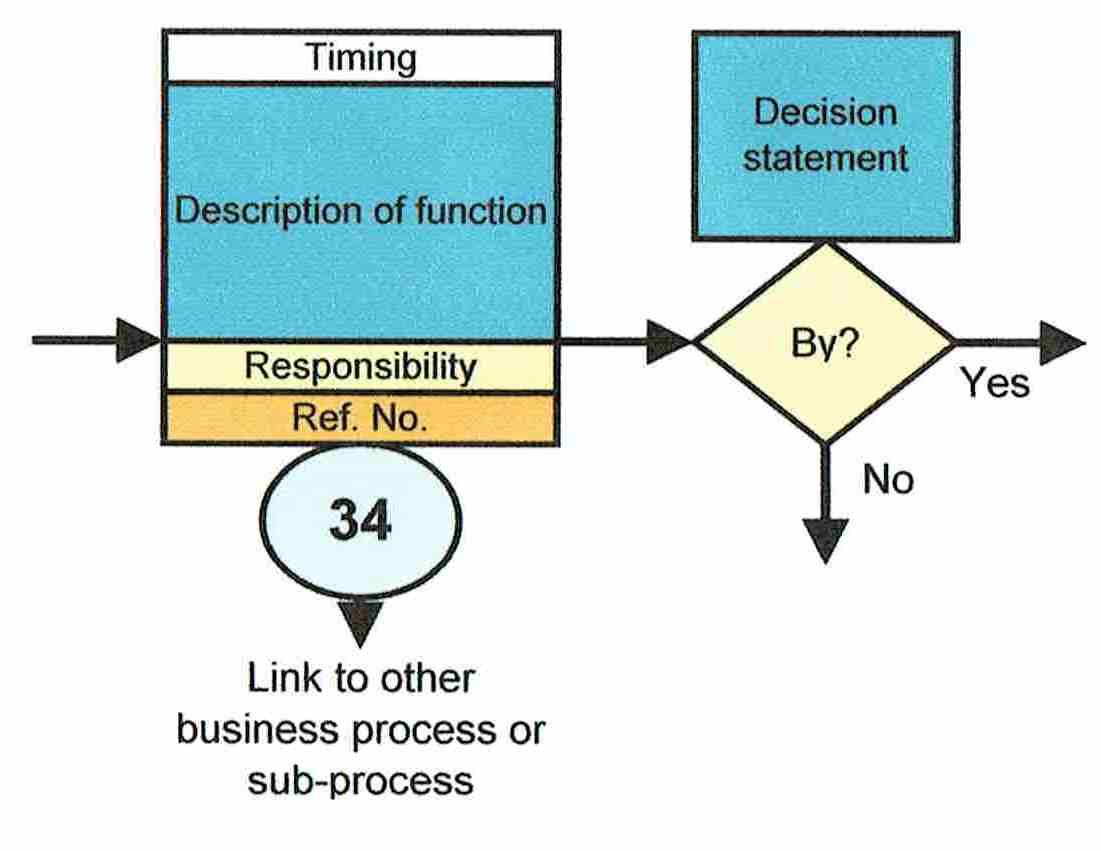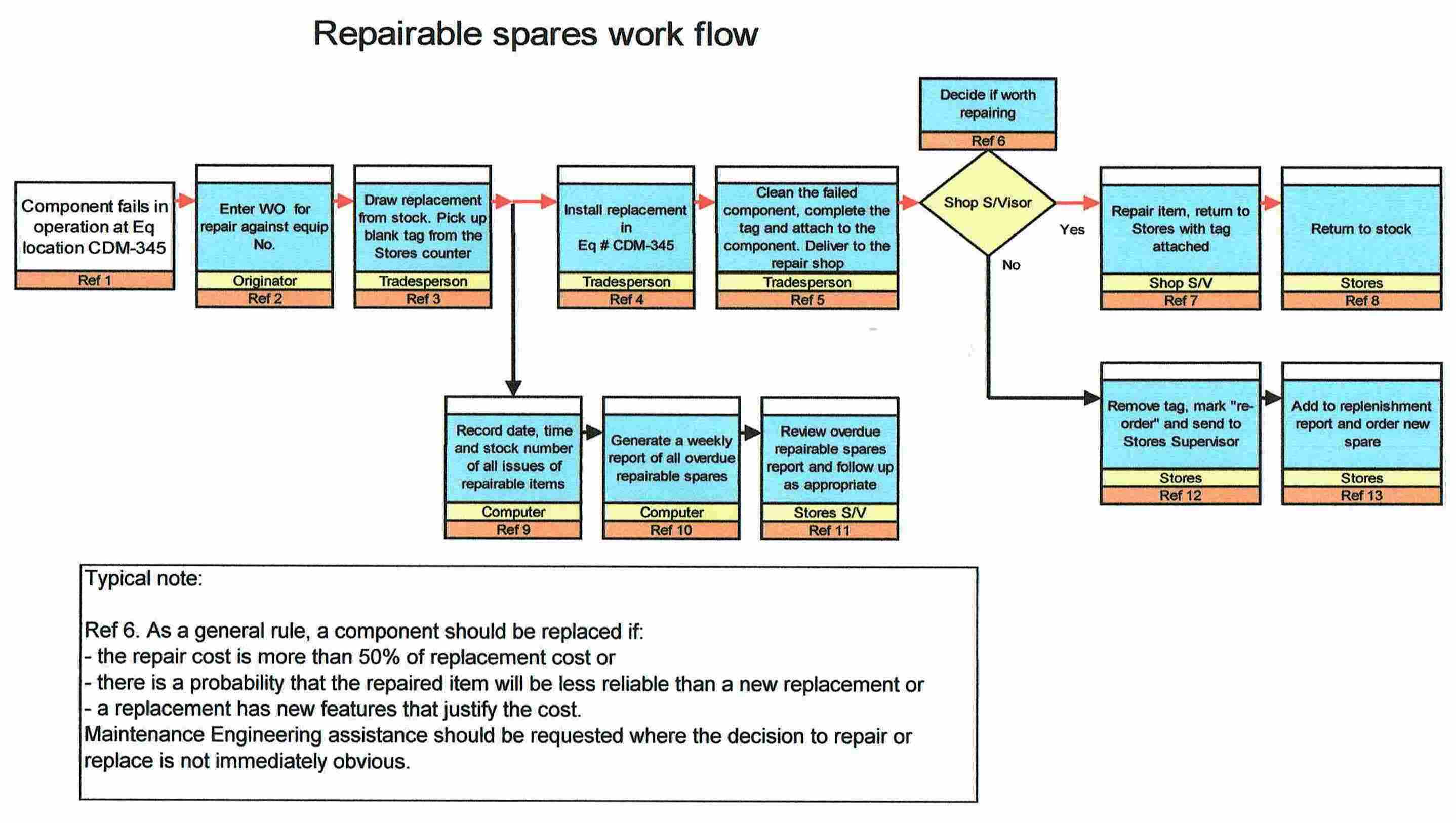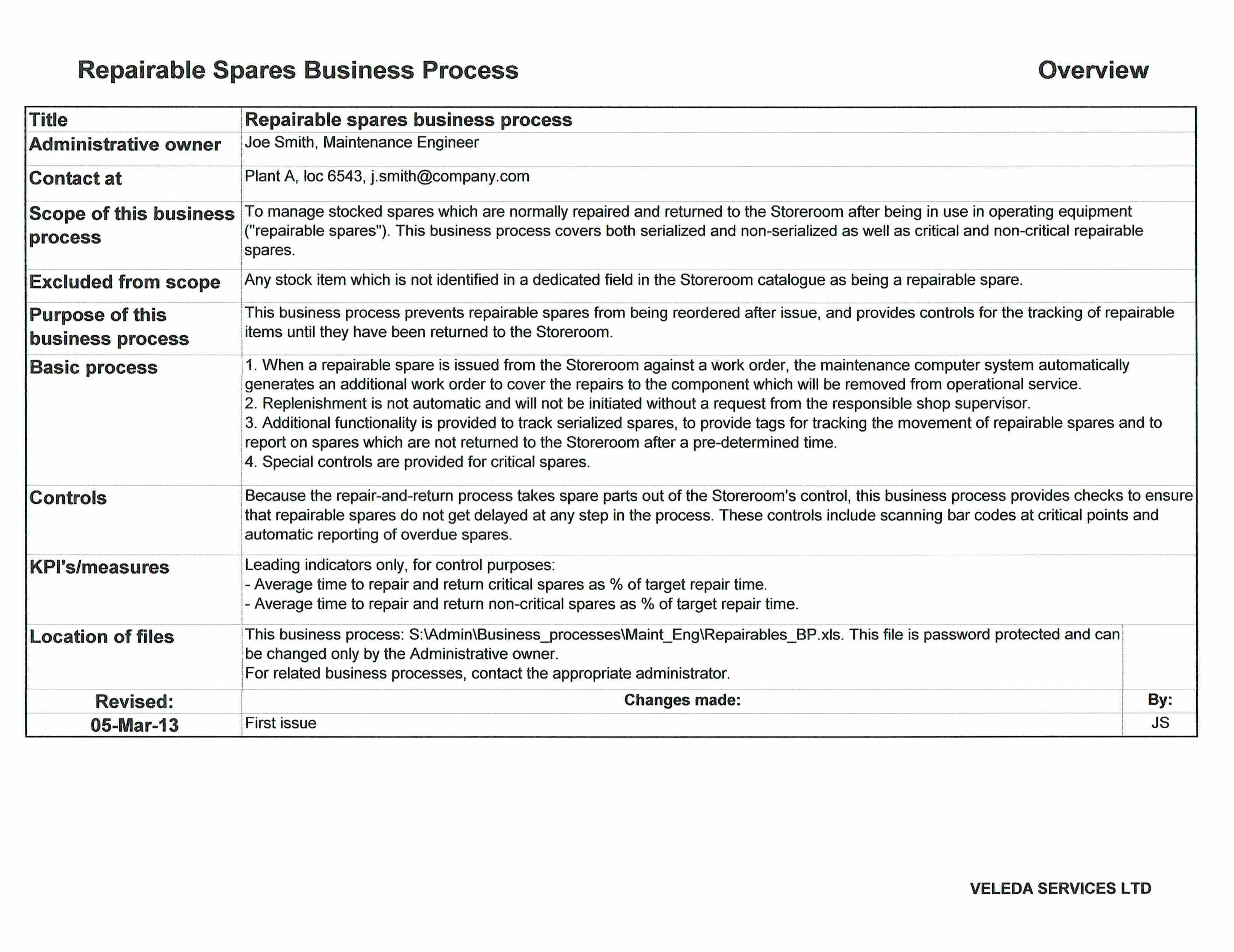This article covers the development of business processes for Maintenance followed by a discussion on the use of business processes as the basis for practical position descriptions.
___________________________________
When visiting institutions and industrial operations it is not uncommon to find that considerable confusion exists over which positions should carry out basic maintenance functions, such as planning, scheduling and supervising work. This is often the result of high turnover in key positions and the absence of clearly documented responsibilities for maintenance functions.
It is also not uncommon to find that, as a result of cost reduction efforts, some very important activities such as the upkeep of spare parts lists or equipment histories have been abandoned and after some time, the results are causing problems.
The best way to address these issues is through well-documented and managed maintenance business processes and, from these, detailed position descriptions.
This article describes maintenance business processes and the way in which they may be developed. It also covers the use of business processes for the development of detailed position descriptions.
A business process describes the sequence of activities and decisions that are required to carry out a function that adds value to an organization. Like the framework of a house, once built they are seldom seen but they are essential for holding things together.
Business processes are not difficult to develop and should always have the purpose of serving the people who manage the business, at all levels.
Wherever there is a form, tag, schedule, report, computer screen, work plan or any other document, it should form part of a business process and it should clearly contribute to a sequence of functions which will result in adding some real value, such as getting a maintenance job completed efficiently.
An important part, but only a part, of any business process is a “work flow” diagram which shows a sequence of actions and decisions in a graphical format. Software, such as MS Visio, can quickly build work flow diagrams, but there is a skill to keeping them simple, logical and easy to read and understand.
Our standard format for a work flow has two basic elements – an action and a decision. For each element, a brief description, the position responsible and, where appropriate, the timing is shown, as illustrated below. To keep the work flow “clean” where additional information is required, a reference number is added to each element and refers to explanatory notes or procedures where these are required.

Our standard also shows the most common flow as a straight line, with branches for exceptions. An example of part of a simplified work flow diagram for managing repairable spare parts is shown below.

Some work flow diagrams may appear complex, but many of the decisions and actions, although important, take very little time or may be automated.
A business process is much more than just a work flow diagram. A complete business process should have the following (numbered) components, complete in every detail:
- A cover page which shows the following information:
– The name of and contact information for the business process “owner” or “Business Process Manager”. His/her responsibilities should include:
- issuing the complete Work Flow to everyone affected by it,
- ensuring that all functions identified on the Work Flow are assigned to the appropriate positions, and are accepted by the incumbents in those positions,
- making timely changes as needed based, primarily, on feedback from business process users,
- ensuring all the people who need to use the business process are trained and competent in its use and
- regularly monitoring the use of the business process and working with department managers to address compliance issues where noted.
– A statement of purpose for the process described by the Work Flow.
– A brief description of the scope of the process.
– A summary of related items which are excluded from the process.
– A brief description of the process itself.
– A brief description of process controls (such as reporting and responsibility for action on reports).
– A list of lagging and leading Key Performance Indicators (KPI’s) used to assess the ongoing value of the process.
– A record of revisions made to the process.
An example of a business process cover sheet is shown below:

- The Work Flow diagram.
- Explanatory notes or procedures, where necessary, for each box on the Work Flow diagram to allow it to remain as compact as possible.
- All forms, computer screens, labels, tags, signs, etc, required to manage the business process.
- Details of all reports required, including a description of the purpose of the report, responsibilities and timing for follow up and report distribution.
- Details of leading and lagging KPI’s and the process and responsibilities for monitoring and reporting performance.
- A description of the computer functionality required to effectively automate the management of the process.
- Detailed training to ensure that all the incumbents in positions identified on the work flow diagram will be competent in the areas for which they are responsible. This should be complemented by a process for recording training.
- A clear definition of all terms and abbreviations used in the business process.
Business process documents, for simplicity, often refer to “sub-processes”. For example, the business process for managing repairable spare parts may refer to a sub-process for the management of serialized repairable spares.
The “reference notes” for a function or decision shown on the work flow diagram may be a complete procedure. For example, for a “work scheduling” business process, the function “Conduct weekly scheduling meeting” may refer to a procedure which describes the conduct of the meeting, including:
– the position that acts as chairperson
– the time and location
– the duration
– any support required (e.g. a computer and screen to display the current schedule)
– required attendance
– the preparation required of each attendee
– the agenda
– the recording process and responsibility
– the process for handling scheduling conflicts
– the distribution of minutes
– the actions resulting from the meeting, with responsibilities
(Scheduling meetings will be the subject of a future article)
Building a business process
Because of their complexity, it may be unwise to involve a lot of people in the initial drafting of a business process, although all who will be affected by the process should have an opportunity for input (see “Successful Change“).
Time and effort will be saved if the process is initially drafted by someone who understands the needs of the business and who has had experience in the area that is covered by the proposed business process. An external advisor with general experience in business process development may be of great assistance at this stage.
The following steps will result in an efficient business process:
- Define the objective
For example – “To address the problem or need identified on a request for maintenance work”.
- List the activities and decisions required to achieve the objective.
It is very important at this stage to ignore the positions that may be responsible for each activity and decision. The initial focus should be on functions only.
Start by considering the most common work flow. Using the example of a request for maintenance work this may require some assumptions, for example:
– the work will be done by one maintenance trade
– it will not require approval
– it does not involve any recordable modifications to equipment
– it does not require a plant shutdown
When this common path is defined, go back and identify where decisions which may result in “branches” in the diagram are required and define these decisions. E.g. “Does this require the involvement of more than one shop?”
From each decision statement, construct the “branch path” of functions and decisions that result.
Where a branch is complex, consider the development of a “sub-process” instead of showing the entire work flow on a single diagram.
- Where an explanatory reference note or procedure is required for any function or decision, draft these notes or procedures.
- When the work flow is fully drafted, study each step carefully and decide what documentation may be required (tags, forms, reports, etc, etc) and draft these.
- Carefully scrutinize each step in the process. Ensure that all necessary actions and decisions are included, and eliminate anything that does not add value.
- At this point, key people who will be affected by the business process should have the opportunity for input. NOTE – the responsibilities for actions and decisions have not yet been assigned.
Discuss and revise the draft business process to ensure that it is as efficient as possible.
- With a small group of key, senior people, study each element of the business process and assign responsibility for each. Consider:
– which position is most likely to have the skills and knowledge to make each decision or carry out each action.
– minimizing the number of times the responsibility for the business process changes hands.
– the balancing of work loads.
– where possible, the maintenance computer system (if there is one) should be assigned “responsibility” for actions and decisions that it can support (e.g. automatically routing a work request for approval based on the priority rating, the equipment number, the reason for the work and the estimated cost).
- Where timing is important, enter this information against each element (e.g. for the weekly scheduling business process, the decision on which areas of the plant will be shut down on any day during the schedule period should be made at least 2 weeks in advance).
- Review the business process again with those who will be affected. Revise as necessary until there is agreement that the process is efficient and functional. It does not have to be perfect, as it can be expected that any business process will evolve over time.
- Where a maintenance computer system is in use, review the business process in detail with the system administrator to ensure that the system can support all elements. Where it can not, make adjustments or changes as necessary (e.g. if the system does not support effective work scheduling, then transfer this function to another system, such as MS Excel).
- Design and implement all supporting reports, KPI’s, etc., with responsibilities for resulting actions.
- Establish a training programme to ensure anyone who is required to use the system can meet the required standards. This will include current and future employees.
- Conduct the training and implement the business process. This may be a project in itself.
Position descriptions
Business processes should form the basis for position descriptions. For each position, the functions and decisions for which the position is responsible on all business process diagrams should be gathered and documented. For example, for a Maintenance Supervisor, functions from various business processes may include:
– “With the Operating Supervisor, review all new work requests before 8:30 am each morning, decide if each should proceed and if so apply a preliminary estimate, a priority rating and decide what level of planning is required…..”
– “Review the outstanding critical spare parts report on Friday each week and contact Purchasing if any items represent a high risk”
– “Review all crew time cards each day and discuss any incorrect entries with tradespeople as required to ensure consistent reporting”
– etc, etc
Complete and up-to-date position descriptions are especially important where there is a rapid turnover through key Maintenance roles. They should be mandatory training tools for new incumbents in any position.
Business Processes and Position Descriptions, like preventive maintenance procedures, should be living documents with ongoing and frequent improvements. In particular, there should be a continuous effort to remove roadblocks that reduce the ability, or increase the cost to provide maintenance support to the organization. For this to happen, each and every business process must have an “owner” who accepts this important responsibility and actively manages the way that the work covered by each business process is done. Once business processes are established and the “bugs” worked out, this should require very little time.
To return to the Articles index click here.
© Veleda Services Ltd
Don Armstrong, P.Eng, President
don.armstrong@veleda.ca
250-655-8267 Pacific Time
Canada